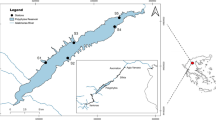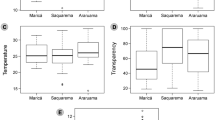Abstract
Patos Lagoon is located off the southern Brazilian coast and represents one of the largest coastal lagoons in the world. We estimated hydrological and physicochemical conditions associated with spatial variation in the abundance and diversity of freshwater fishes along the lagoon, and inter-annual variability in abundances of freshwater fishes occurring in its estuarine zone. During our study, the region experienced two periods of average rainfall and two periods with above-average rainfall. The characids Astyanax eigenmaniorum and Oligosarcus jenynsii and the siluriform Parapimelodus nigribarbis were the most abundant freshwater fishes in the estuary during wet periods when water levels were higher and salinity was lower. Increases in abundance of these species in the estuarine area, all of which members of primary-division freshwater families, apparently were associated with pulses of reproduction and passive transport from freshwater habitats located near middle and upper lagoon reaches. Abundance of species from secondary freshwater families, such as poeciliids and cichlids, were less correlated with hydrological conditions, and their patterns of occurrence in the estuary suggest active migration from nearby freshwater habitats draining into this area. Findings indicate that freshwater discharge in the basin and expansion/retraction of freshwaters in the middle-upper lagoon determined patterns of freshwater fish abundance and species richness in the estuarine zone.
Similar content being viewed by others
References
Agostinho, A.A. & H.F. Julio. 1996. Peixes de outras águas. Ciência Hoje 21: 36-44.
Bennett, A.F., B.S. Chua, D.E. Harrison & M.J. Mcphaden. 2000. Generalized inversion of tropical atmosphere-ocean (TAO) data and a coupled model of the tropical Pacific. Part II: the 1995-96 La Niña and 1997-98 El Niño. J. Clim. 13: 2770-2785.
Bertaco, V.A. & F.G. Becker. 2000. Observações sobre a abundância de Parapimelodus nigribarbis (Boulenger, 1889) (Pimelodidae) no lago Guaíba, Rio Grande do Sul, Brasil. Comunicações do Museu de Ciência e Tecnologia da PUCRS, Porto Alegre Série Zoológica 13: 185-195.
Bertaco, V.A., Z.M.S. Lucena & F.G. Becker. 1998. Variação espacial e temporal na abundância de Astyanax bimaculatus e Astyanax fasciatus (Characidae) no lago Guaíba, Rio Grande do Sul, Brasil. Comunicações do Museu de Ciência e Tecnologia da PUCRS, Porto Alegre Série Zoológica 11: 61-89.
Blaber, S.J.M. 1997. Fish and Fisheries of Tropical Estuaries, Chapman Hall, London. 367 pp.
Chao, L.H., L.E. Pereira & J.P. Vieira. 1985. Estuarine fish community of the dos Patos Lagoon, Brazil. A baseline study. pp. 429-450. In: A. Yanez-Arancibia (ed.) Fish Community Ecology in Estuaries and Coastal Lagoons: Towards an Ecosystem Integration, DR (R) UNAM Press, Mexico.
Day, J.W., C.A.S. Hall, W.M. Kemp & A.Yanez-Arancibia. 1989. Estuarine Ecology, John Wiley & Sons, New York. 558 pp.
de Yuan, E.C. & C.P. de Hassan. 1985. Fish population in the Paraná river: Lentic environments of Diamante and San Pedro areas (Argentine Republic). Hydrobiologia 127: 213-218.
Diaz, A.F., C.D. Studzinski & C.R. Mechoso. 1998. Relationships between precipitation anomalies in Uruguay and southern Brazil and sea surface temperature in the Pacific and Atlantic Oceans. J. Clim. 11: 251-271.
Elliott, M. & F. Dewailly. 1995. The structure and components of European estuarine fish assemblages. Netherlands J. Aqua. Ecol. 29: 397-417.
Fernandez, O.A., K.J. Murphy, A. Lopez Cazorla, M.R. Sabbatini, M.A. Lazzari, J.C.J. Domaniewski & J.H. Irigoyen. 1998. Interrelationships of fish and channel environmental conditions with aquatic macrophytes in an Argentine irrigation system. Hydrobiologia 380: 15-25.
Garcia, A.M. & J.P. Vieira. 2001. O Aumento da diversidade de peixes no estuário da Lagoa dos Patos durante o episódio El Niño 1997-1998. Atlântica, Rio Grande 23: 85-96.
Garcia, A.M., J.P. Vieira & K.O.Winemiller. 2001. Dynamics of the shallow-water fish assemblage of the Patos Lagoon estuary (Brazil) during cold and warm ENSO episodes. J. Fish Biol. 59: 1218-1238.
Garcia, A.M., J.P. Vieira & K.O. Winemiller. 2003. Effects of 1997-1998 El Niño on the dynamics of the shallow-water fish assemblage of the Patos Lagoon estuary (Brazil). Estu. Coast. Shelf Sci. 57: 489-500.
Glantz, M.H. 2001. Currents of Change: Impacts of El Niño and La Niña on Climate and Society, Cambridge University Press, Cambridge. 252 pp.
Green, S.B., N.J. Salkind & T.M. Akey. 2000. Using SPSS for Windows, Prentice Hall, New Jersey. 430 pp.
Grimm, A.M., V.R. Barros & M.E. Doyle. 2000. Climate variability in Southern America associated with El Niño and La Niña events. J. Clim. 13: 35-58.
Grosman, M.F., J.R. Gonzalez Castelain & E.J. Usunoff. 1996. Trophic niches in an Argentine pond as a way to assess functional relationships between fishes and other communities. Water SA 22: 345-350.
Haimovici, M., J.P. Castello & C.M. Vooren. 1996. Fisheries. pp. 183-196. In: U. Seeliger, C. Odebrecht & J.P. Castello (ed.) Subtropical Convergence Environments: The Coastal and Sea in the Southwestern Atlantic, Springer Verlag, New York.
Hartz, S.M., A. Martins & G. Barbieri. 1996. Dinâmica da alimentação e dieta de Oligosarcus jenynsii (Gunther, 1864) na Lagoa Caconde, Rio Grande do Sul, Brasil (Teleostei, Characidae). Boletim do Instituto de Pesca, São Paulo 23: 21-29.
Hartz, S.M., F.S. Vilella & G. Barbieri. 1997. Reproduction dynamics of Oligosarcus jenynsii (Characiformes, Characidae) in Lake Caconde, Rio Grande do Sul, Brazil. Revista Brasileira de Biologia 57: 295-303.
Helfman, G.S., B.B. Collette & D.E. Facey. 1997. The Diversity of Fishes, Blackwell Science, Malden, Massachusetts. 528 pp.
Kane, R.P. 1999a. Rainfall extremes in some selected parts of central and south America: ENSO and other relationships reexamined. J. Climatol. 19: 423-455.
Kane, R.P. 1999b. Some characteristics and precipitation effects of the El Niño of 1997-1998. J. Atmos. Solar-Terr. Phys. 61: 1325-1346.
Kjerfve, B. 1986. Comparative oceanography of coastal lagoons. pp. 63-81. In: D.A.Wolfe (ed.) EstuarineVariability, Academic Press, Orlando.
Leigh, P.J. 1996. Seasonal climate summary southern hemisphere (summer 1995-96): A weak Pacific cool episode (La Niña) begins to decline. Aust. Meteorol. Mag. 45: 203-211.
Livingston, R.J., X. Niu, F.G. Lewis III & G.C. Woodsum. 1997. Freshwater input to a gulf estuary: Long-term control of trophic organization. Ecol. Appl. 7: 277-299.
Lobón-Cerviá, J. 1996. Response of a stream fish assemblage to a severe spate in northern Spain. Trans. American Fish. Soc. 125: 913-919.
Lucena, A.S., L.R. Malabarba & R.E. Reis. 1992. Resurrection of the Neotropical Pimelodid catfish Parapimelodus nigribarbis (Boulenger), with a phylogenetic diagnosis of the genus Parapimelodus (Teleostei: Siluriformes). Copeia 1: 138-146.
Martinez-Palacios, C.A. & L.G. Ross. 1992. The reproductive biology and growth of the central American cichlid Cichlasoma urophthalmus (Gunther). J. Appl. Ichthyol. 8: 99-109.
Matheney, M.P.I. & C.F. Rabeni. 1995. Patterns of movement and habitat use by northern hog suckers in an Ozark stream. Trans. American Fish. Soc. 124: 886-897.
Mcphaden, M.J. 1999. The child prodigy of 1997-98. Nature 298: 559-562.
Meffe, G.K. 1984. Effects of abiotic disturbance on coexistence of predator-prey fish species. Ecology 65: 1525-1534.
Menezes, N.A. 1987. Três espécies novas de Oligosarcus Gunther, 1864 e redefinição taxonômica das demais espécies do gênero (Osteichthyes, teleostei, Characidae). Boletim de Zoologia, Universidade de São Paulo 11: 1-39.
Mol, J.H., D. Resida, J.S. Ramlal & C.R. Becker. 2000. Effects of El Niño-related drought on freshwater and brackish-water fishes in Suriname, South America. Environ. Biol. Fishes 59: 429-440.
Moller, O.O.J., P. Casting, J.-C. Salomon & P. Lazure. 2001. The influence of local and non-local forcing effects on the subtidal circulation of Patos Lagoon. Estuaries 24: 297-311.
Moyle, P.B. & T. Light. 1996. Biological invasions of fresh water: empirical rules and assembly theory. Biol. Conserv. 78: 149-161.
Myers, G.S. 1938. Freshwater fishes and West Indian zoogeography. Ann. Rep. Smithson. Inst. 1937: 339-364.
Nichols, F.H., J.K. Thompson & L.R. Schemel. 1990. Remarkable invasion of San Francisco Bay (California, U.S.A.) by the Asian clam Potamocorbula amurensis, II. Displacement of a former community. Mar. Ecol. Prog. Ser. 66: 95-101.
Orsi, M.L. & A.A. Agostinho. 1999. Introdução de espécies de peixes por escapes acidentais de tanques de cultivo em rios da Bacia do Rio Paraná, Brasil. Revue Brasilioc Zoologic 16: 557-560.
Poli, C.R., A. Grumann & J.R. Borghetti. 2000. Situação atual da aquicultura na região sul. pp. 399. In: W.C. Valenti, C.R. Poli, J.A. Pereira & J.R. Borghetti (ed.) Aquicultura no Brasil: Bases Para Um Desenvolvimento Sustentável, CNPq/MCT, Brasília.
Potter, I.C., L.E. Beckley, A.K. Whitfield & R.C.J. Lenanton. 1990. Comparisons between the roles played by estuaries in the life cycles of fishes in temperate western Australia and southern Africa. Environ. Biol. Fishes 28: 143-178.
Rao, V.B. & K. Hada. 1990. Characteristics of rainfall over Brazil: Annual variations and connections with the southern oscillation. Theor. Appl. Climatol. 42: 81-91.
Rebelo, J.E. 1992. The ichthyofauna and abiotic hydrological environment of the Ria de Aveiro, Portugal. Estuaries 15: 403-413.
Reis, E.G. & F. D'incao. 2000. The present status of artisanal fisheries of extreme Southern Brazil: An effort towards community-based management. Ocean Coast. Manage. 43: 585-595.
Scrimgeour, G.J. & M.J. Winterbourn. 1987. Diet, food resource partitioning and feeding periodicity of two riffle-dwelling fish species in a New Zealand river. J. Fish Biol. 31: 309-324.
Seeliger,U. 2001. The Patos Lagoon estuary, Brazil. pp. 167-182. In: U. Seeliger & B. Kjerfve (ed.) Coastal Marine Ecosystems of Latin American, Springer Verlag, Berlin.
Swales, S., A.W. Storey, I.D. Roderick & B.S. Figa. 1999. Fishes of floodplain habitats of the Fly River system, Papua New Guinea, and changes associated with El Niño droughts and algal blooms. Environ. Biol. Fishes 54: 389-404.
Tagliani, P.R.A. 1994. Ecologia da assembléia de peixes de três riachos da planície costeira do Rio Grande do Sul. Atlântica, Rio Grande 16: 55-68.
Underwood, A.J. 1997. Experiments in Ecology-Their Logical Design and Interpretation Using Analysis of Variance, Cambridge University Press, Cambridge. 504 pp.
Vieira, J.P. & J.P. Castello. 1996. Fish fauna. pp. 56-61. In: U. Seeliger, C. Odebrecht & J.P. Castello (ed.) Subtropical Convergence Marine Ecosystem. The Coast and the Sea in the Warm Temperate Southwestern Atlantic, Springer Verlag, New York.
Vieira, J.P. & J.A. Musick. 1994. Fish fauna composition in warm-temperate and tropical estuaries of western Atlantic. Atlântica, Rio Grande 16: 31-53.
Watkins, A.B. 2000. Seasonal climate summary southern hemisphere (spring 1999): A transition toward a second successive cool episode (La Nina). Aust. Meteorol. Mag. 49: 319-330.
Webb, P.W., C.L. Gerstner & S.T. Minton. 1996. Station-holding by the mottled sculpin, Cottis bairdi (Teleostei: Cottidae), and other fishes. Copeia 2: 488-493.
Whitfield, A.K. 1999. Ichthyofaunal assemblages in estuaries: A south African case study. Rev. Fish Biol. Fish. 9: 151-186.
Winemiller, K.O. & M.A. Leslie. 1992. Fish assemblages across a complex, tropical freshwater/marine ecotone. Environ. Biol. Fishes 34: 29-50.
Author information
Authors and Affiliations
Rights and permissions
About this article
Cite this article
Garcia, A.M., Raseira, M.B., Vieira, J.P. et al. Spatiotemporal Variation in Shallow-Water Freshwater Fish Distribution and Abundance in a Large Subtropical Coastal Lagoon. Environmental Biology of Fishes 68, 215–228 (2003). https://doi.org/10.1023/A:1027366101945
Issue Date:
DOI: https://doi.org/10.1023/A:1027366101945




